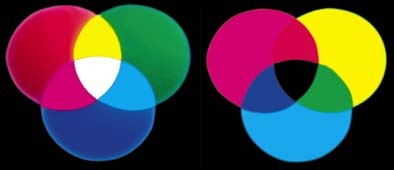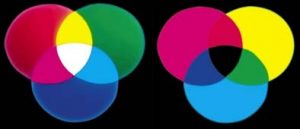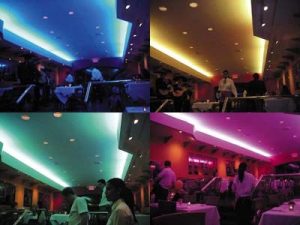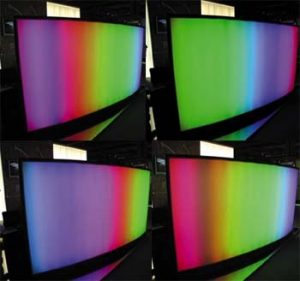LEDs + Lighting
Times of Change
Color-changing and color-mixing neon
Published
18 years agoon

Mixed- and changeable-color, artificial light has been used onstage since electrical illumination entered the theatrical scene. In the last decade, light designers have discovered that architectural illumination that changes with time of day or year could give a building dynamic character. The development of white LEDs and LED screens has made multiple colors possible, and quite popular, for LED-suitable lighting applications.
At this year’s "light + building" show in Frankfurt, multiple companies offered such LED-based systems (see ST, June 2004, page 24). What was presented at the show as cutting edge is simply classic neon technology. Architects increasingly use color-mixing neon instead of LEDs. I’ll explain why and how it’s done.
Color changing
Color-changing neon differs from color-mixing neon. Color-changing neon comprises one neon tube that shows different colors. Japanese research has spurred a few patents of power supplies that ionize neon and mercury in a single tube, separately or simultaneously.
When only the neon is excited, the tube glows clear red; when mercury is stimulated, it illuminates clear blue. Combined ionization yields varying shades of pink. Coated tubes also produce myriad combinations of pumped argon/mercury and neon.
This system’s downside is its low intensity, even with a high-powered, electronic transformer. Low-power applications are easy, but the higher you push the intensity, the more likely both gases will be lit and produce pinkish shades — not pure red or blue. It’s almost impossible to obtain a higher intensity than a 15- to 20mA transformer provides while separating colors. Also, the voltage requirement is immense. For example, one 15,000V, shoebox-size power supply (which costs approximately $1,000) powers only two, 5-ft. sticks of 15mm glass. The system works quite well, and cheaply, with low power.
Color mixing
In contrast to color changing, color mixing indicates using separate neon tubes to obtain a color. To understand additive-color mixing, look at a picture-tube TV screen (or computer monitor) using a magnifying glass. You’ll see tiny spots, or stripes of red, green and blue. The tubes’ color coordinates determine potential color coverage with a color-mixing system.
Let’s first consider a two-tube system. Each tube has a color coordinate on the CIE color system. Mark the points of both tubes in the chart, and draw a straight line between them. All available colors within this two-channel system will be found on this line. For a three-channel system (normally red, green and blue [RGB]), I can draw a triangle wherein each color represents a point. Changing the tubes’ intensity ratio produces all colors within this triangle.
Thus, to obtain a large area containing a wide color range, the tube (or primary) colors should be located in the far corners of the CIE chart. Or, they should be very saturated colors near the edge of the curve, as with classic, colored glass.
Further, every three-channel system becomes a two-channel system when one tube isn’t illuminated. So, all possible colors can be found on the line that connects the two, active tube colors or one side of the triangle.
Let’s return to color-point determination in a two-channel system. Luminous intensities of neon tubes differ; they may vary by a factor of five to eight under identical operating conditions. With equal intensities, you’d expect the color mix to bisect the two points in the center of the line. However, for a very rough estimate, anticipate the color point to be at the ratio of both primary color tubes’ lumen-per-ft. intensities — closer to the one with higher output. With a standard RGB system, red normally has the lowest intensity; green has the highest.
If your three-tube set has identical geometry and length, you’ll never obtain white when all tubes are set to 100% current (presuming identical transformer controls for all three channels). Rather, you’ll merely achieve a pastel-green tint. If you want to uniformly light a box, adjust the tube so the least intense color (red) will be the longest tube, and the most intense (green), the shortest.
A rough calculation can be made with the tube suppliers’ lumens-per-ft. lengths. Match the footage of the single colors so their total lumen output is the same ratio as the primary color point from the desired white. Distributing this tube length is a different task I’ll discuss later.
If the architectural environment doesn’t permit different tube lengths for each color, the ideal white will be reached with circuits set to unequal power levels. In other words, the white balance becomes a software problem.
The position of the tubes in a cove or lightbox is critical. They shouldn’t block the light or cast shadows of other colors. Thus, clear red is often chosen over ruby-red argon because the clear-red tube is transparent for other colors, and it can be situated atop other tubes. The distance from the tubes to the scattering surface, whether it’s a wall, cove or lightbox cover, impacts the effect.
I recommend experimentation with different face materials. My rule of thumb is: The more dense the (frosted) white, the closer you can put the tubes (while keeping acceptable uniformity). But, more light is lost.
However, there’s a compromise. Acrylics showing two different surface finishes — the rough side pointing toward the tube will provide additional scattering and balance shadows in shallow boxes — often provide good results.
The electrical side
Different methods and philosophies may control two or more channels. Of course, someone could build his own controls and use a standard transformer. But, digital controls using the DMX-512 protocol, first introduced to manage stage lighting, have been widely adopted for color-mixing neon. Control units range from small, handheld consoles to expansive, PC-based, cellphone-patched command centers that accept data from various sources.
If someone uses larger circuits normally set to a similar color and intensity, high-voltage neon or cold-cathode transformers are simple to use and cost effective.
When selecting UL 2161-compliant transformers, contact the manufacturer or distributor to ensure the particular model is designed for unlimited dimming; otherwise, the protection may keep tripping at no fault. The interface between the controller and neon transformer decodes the digital signal for each channel and converts it into a dimmer setting at the addressed output for the transformers.
Thus, a change in the digital value for channel X — for instance, one assigned to the red tubes — will appear in the equivalent change of the power to the neon tube and alter the red’s brightness in fractions of a second.
If you plan to use existing, DMX-controllable dimmers for neon/cold-cathode color mixing, use heavy-duty, stage models explicitly designed for inductive (motor) loads. Others will likely turn into smoke within seconds.
Electronic transformers simplify matters. However, for installations with many animated channels that create dynamic effects, the use of separate control units, and magnetic transformers for each channel, are cost prohibitive.
Today, different electronic-component manufacturers include British manufacturer Mode Lighting’s Digitron/Colortran, or German-based Hansen Neon’s Dimmbox, which provide independent, high-voltage output for up to three channels from a single electronic box controlled by a direct computer connection. Generally, the output is limited to 990V to accommodate a low-voltage installation, which limits tube length to 8 ft. or less for a 25mm tube (shorter for smaller tube diameters).
With electronic units, protection isn’t a concern; built-in components are matched to the dimming service requirements. An Italian product slated for a November introduction offers four channels (red, green, blue and white), improved color rendering and white balance.
Color-changing and color-mixing neon — as well as other types of dynamic lighting — can influence feelings. However, in times of change, don’t let colorful lights sway you.
SPONSORED VIDEO
Introducing the Sign Industry Podcast
The Sign Industry Podcast is a platform for every sign person out there — from the old-timers who bent neon and hand-lettered boats to those venturing into new technologies — we want to get their stories out for everyone to hear. Come join us and listen to stories, learn tricks or techniques, and get insights of what’s to come. We are the world’s second oldest profession. The folks who started the world’s oldest profession needed a sign.
You may like
Advertisement
Subscribe

Magazine
Get the most important news
and business ideas from Signsofthetimes Magazine.
Advertisement
Most Popular
-

 Photo Gallery1 week ago
Photo Gallery1 week ago30 Snapshots of the 2024 ISA Sign Expo
-

 Ask Signs of the Times1 week ago
Ask Signs of the Times1 week agoWhy Are Signs from Canva so Overloaded and Similar?
-

 Paula Fargo5 days ago
Paula Fargo5 days ago5 Reasons to Sell a Sign Company Plus 6 Options
-

 Real Deal2 days ago
Real Deal2 days agoA Woman Sign Company Owner Confronts a Sexist Wholesaler
-

 Benchmarks2 weeks ago
Benchmarks2 weeks ago6 Sports Venue Signs Deserving a Standing Ovation
-

 Photo Gallery5 days ago
Photo Gallery5 days ago21 Larry Albright Plasma Globes, Crackle Tubes and More
-

 Women in Signs1 week ago
Women in Signs1 week ago2024 Women in Signs: Brandi Pulliam Blanton
-

 Women in Signs1 week ago
Women in Signs1 week ago2024 Women in Signs: Alicia Brothers













